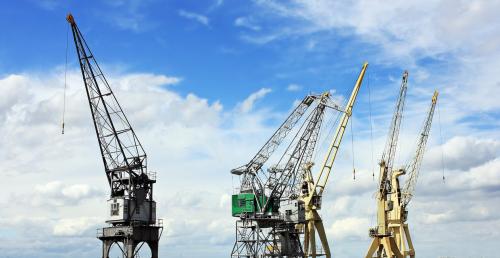Mobile Crane Safety: How to Avoid Tipping Incidents and Accidents

Cranes are tremendously powerful pieces of equipment that enable the movement and lifting of heavy loads on job sites. Mobile cranes are controlled by cables and pulleys and are mounted on a prime mover to facilitate transportation and lifting of heavy objects to and from a site.
In addition to providing stability and support in a wide range of applications, cranes also increase efficiency and productivity, especially modern revolutionized machines that are equipped with crane safety systems.
However, maneuvering a giant, powerful machine such as a crane doesn’t come without its dangers. Research by the Bureau of Labor Statistics reveals that more than 297 deaths have been reported due to improper handling in the past few years, with at least one accident occurring for every 8,000 hours of crane usage in the United States? And more than 26% of the accidents can be attributed to crane operators' momentary distraction or negligence during rigging, setup, operation, or lifting.
Tripping accidents are among the most common and understated incidents faced by crane operators, who overlook or fail to adhere to safety guidelines set by manufacturers regarding crane ratings. Let's try to understand what tripping is, why it occurs, and how to avoid it from becoming a fatal accident.
Prime Causes of Tipping
- When cranes are loaded with more weight than they are designed to lift, they often lead to tipping accidents in the load direction.
- Sometimes if the crane loses stability, it can turn over to any direction, causing severe injuries to the crane operator and damaging the objects being lifted, leading to significant losses.
- A crane can tip if the counterweights used to set the level aren't sufficient.
- Another reason why cranes often fail to carry heavy loads is when their external supports, which are also known as outriggers and function to anchor them to the ground, are faulty or not fully extended.
- When the crane is not firmly secured to the terrain or is set on unsuitable, unstable, or soft ground.
Fast Fact: Although it’s pretty uncommon, but heavy winds can also cause crane-related accidents. An incident was reported in the late 1990s where an enormous crane, known as ‘Big Blue,’ fell while lifting a heavy roof panel due to the gusts of winds that were blowing at the speed of 35 mph.
Tipping Point
Crane operators are trained to use the length of the boom, the angle at which the boom extends, and other factors mentioned in load charts to determine the maximum weight that the model of the crane being used can sustain.
Complete crane load charts encompass a tipping line that separates it into two halves. In case the operator miscalculates the weight, being on one side of the line will cause it to tip, while if the overload leans on the other side, it might not tip but can significantly damage the crane.
Ways to Avoid Tipping
Always Stabilize Crane Before Rigging
Use crane pads or outrigger pads and read the manufacturer's manual and guidelines to identify how far outriggers can be extended because improper outrigger setup can cause tipping.
Make a solid safety assessment to understand outrigger placements and avoid placing them over depressions, voids, or unsteady ground.
Extra Tip: Experts recommend operating the initial lift in an unstable direction and gradually swinging to a more stable path. This will enable you to realize if and when the crane has been overloaded or will signify if the load's limit has entered a dangerous position that can cause tipping.
Rig Load Properly
Correctly rigged loads prevent objects from potentially falling over and hurting workers present on the job site. Here’s what you should consider while rigging loads.
Sling Angle
Additional forces are induced on slings if any angle apart from the typical vertical angle is used, leading to a significant reduction in the overall weight-bearing capacity. Ensure that properly rated slings are used for the particular required angle.
Hitching
Understand the weight distribution of the object that needs lifting to identify which hitch configurations and attach slings will work most efficiently.